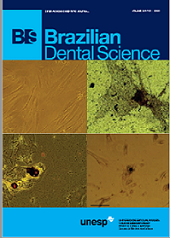Preventive and therapeutic effects of relaxin on bisphosphonaterelated osteonecrosis of the jaw: an experimental study in rats
DOI:
https://doi.org/10.14295/bds.2020.v23i1.1846Resumo
Objective: Bisphosphonate-related osteonecrosis of the jaw (BRONJ) is a challenging complication of chronic bisphosphonate (BP) use. The hormone relaxin is able to induce the multistep differentiation process of human osteoclastogenesis, exhibits anti-fibrotic and anti-inflammatory actions, and promotes vasodilatation, wound healing, and angiogenesis. The present study aimed to evaluate the effects of relaxin in the prevention and management of BRONJ. Material and Methods: Thirty-six male Sprague Dawley rats were randomly divided into four groups. Rats in group 1 (n = 10) received relaxin and BP simultaneously for 12 weeks. Rats in group 2 (n = 10) received injections of BP for 12 weeks, followed by relaxin for another 12 weeks. Rats in group 3 (n = 10) received only BP injections, and those in group 4 (control, n = 6) received only saline. Necrosis and inflammation in the rats’ mandibles were evaluated as indicators of BRONJ. Results: Necrosis and inflammation were not detected in group 1 (BP + relaxin). In group 3 (BP only), incidence rates of necrosis and inflammation were 90% and 60%, respectively. Conclusions: Our findings suggest that relaxin may be potently effective in preventing BRONJ and have some benefit in the treatment of existing BRONJ.
KEYWORDS
Animal model; BRONJ; Relaxin.
Downloads
Downloads
Arquivos adicionais
Publicado
Como Citar
Edição
Seção
Licença
TRANSFERÊNCIA DE DIREITOS AUTORAIS E DECLARAÇÃO DE RESPONSABILIDADE
Toda a propriedade de direitos autorais do artigo "____________________________________________________________________" é transferido do autor(es) para a CIÊNCIA ODONTOLÓGICA BRASILEIRA, no caso do trabalho ser publicado. O artigo não foi publicado em outro lugar e não foi submetido simultaneamente para publicação em outra revista.
Vimos por meio deste, atestar que trabalho é original e não apresenta dados manipulados, fraude ou plágio. Fizemos contribuição científica significativa para o estudo e estamos cientes dos dados apresentados e de acordo com a versão final do artigo. Assumimos total responsabilidade pelos aspectos éticos do estudo.
Este texto deve ser impresso e assinado por todos os autores. A versão digitalizada deverá ser apresentada como arquivo suplementar durante o processo de submissão.
























